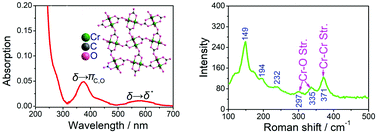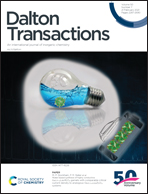Chromous carbonates containing a square-grid layer of {Cr2(CO3)4}n4n− based on a dichromium(ii,ii) paddlewheel core†
Abstract
Polymeric coordination compounds based on Cr2n+ paddle-wheel building blocks with non-carboxylate O,O-donor ligands chelating and bridging the Cr–Cr centers have been underexplored hitherto. This paper reports the synthesis and crystal structure of a new homo-valent chromium(II,II) compound, Na3HCr2(CO3)4·10H2O (1). It has a two-dimensional structure in which the paddlewheel chromium(II,II) units of Cr2(CO3)44− are cross-linked through the carbonate groups. The layers are stacked along the [100] direction, and Na ions fill the intra and interlayer spaces with a neighboring layer distance of about 11.3 Å. The investigation of the primary magnetic properties and theoretical studies with density functional theory (DFT) reveal the partial paramagnetic properties of compound 1 arising from the Boltzmann distribution between a ground state σ2π4δ2 with S = 0 and a low-lying excited state σ2π4δδ* with S = 1 for the Cr2(II,II) dimer. According to Raman spectra measurements combined with theoretical calculations, the two Raman bands in the small-wavenumber region at 335 and 297 cm−1 were assigned to the vibration of the Cr–O bonds and the band at 371 cm−1 was assigned to the stretching of the Cr–Cr quadruple bond.



 Please wait while we load your content...
Please wait while we load your content...